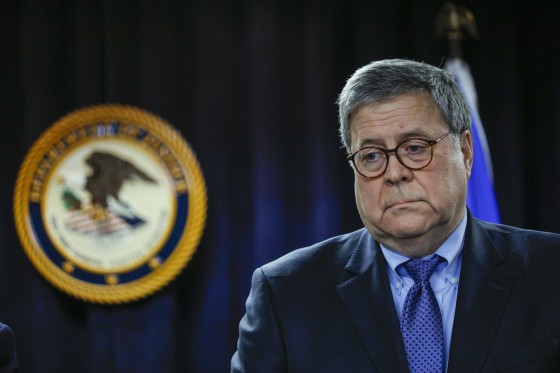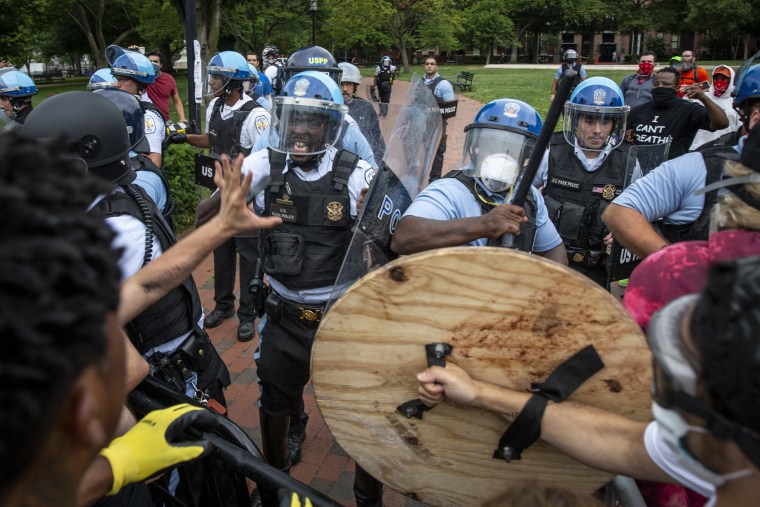Watchdog slams ex-AG William Barr over ‘chaotic’ response to 2020 Black Lives Matter protests
Donald Trump’s former attorney general pressed for action from DOJ entities that “lacked the proper equipment and training” for riot response, an inspector general report found.

WASHINGTON — The Justice Department’s internal watchdog on Wednesday issued a damning report criticizing former Attorney General William Barr for overseeing a “chaotic and disorganized” response to protests, unrest and rioting in the nation’s capital following the 2020 murder of George Floyd.
The report found that Barr, who served as attorney general under then-President Donald Trump in 2019 and 2020, “pressed DOJ law enforcement components to deploy personnel without sufficient attention to whether those personnel were properly trained or equipped for their mission.”
The Justice Department’s inspector general criticized the deployment of government agents who weren’t wearing uniforms that noted the agency they belonged to, let alone wearing name tags or numbers that would allow them to be individually identified if they used excessive force, in responding to protests in 2020.
“We were troubled by the Department leadership’s decision-making that required DOJ law enforcement agents and elite tactical units to perform missions for which they lacked the proper equipment and training,” the report from DOJ’s Office of Inspector General stated. “Multiple witnesses also told us that leadership did not timely and effectively communicate these deployment decisions to subordinates and non-DOJ agencies involved in the response.”
It was Barr’s idea to bring in federal prison employees to handle civilian protests, even though those employees had no experience with such situations and were only used to handling unrest in carceral institutions where individuals were convicted criminals with restricted constitutional rights, as opposed to free American citizens with full rights under the constitution.
At the time, a senior Justice Department praised Barr’s move, saying it reflected “outside the box“ thinking, and saying they’d done “amazing” with the logistical elements.
But multiple experts, including a former Justice Department inspector general, contemporaneously criticized the approach, particularly the deployment of anonymous federal agents from an unknown agency patrolling the streets of Washington during a volatile situation.
“Overall, we shared the serious concerns expressed to us by law enforcement personnel and were most troubled by the Department leadership’s decision-making in putting DOJ law enforcement agents and elite tactical units in close proximity to the public and requiring them to perform missions for which they lacked the proper equipment and training,” the report stated. “Multiple law enforcement witnesses told us that these deployment decisions appeared to have been made hastily and without sufficient understanding of, and priority given to, the capabilities of those deployed, and that leadership did not timely and effectively communicate their decisions to subordinates and other non-DOJ agencies involved in the response.”
Directions from Justice Department leaders led to “standard practices being set aside, resulting in law enforcement components having to compromise between following the Department’s directives and ensuring that any deployments were safe and effective.”
Neither Barr nor a number of other former DOJ officials cooperated with the inspector general’s investigation. Barr did not to a request for comment from NBC News.

Barr, the report said, “was directly involved in making tactical decisions that typically are handled by the Department’s law enforcement components, such as decisions about the deployment of agents to particular locations.”
The report specifically referenced Bureau of Prisons (BOP) officers being deployed to an area outside the White House on June 1, 2020, when law enforcement cleared protesters before Trump walked across the street to a nearby church and held a Bible for cameras.
Barr’s chief of staff sent an email at the time telling the BOP “to deploy personnel to the White House immediately” even though BOP staff had “received no guidance” about their mission or rules of engagement, the report said.
“One BOP supervisor stated that he did not have his personnel bring shields with them because they were unaware that they were going to be assisting with crowd control,” the inspector general report said. “It was not until after they arrived at Lafayette Park that they learned of their role, less than an hour before the clearing operation began.”
The report concluded that Barr “did not impact the timing of the clearing operation,” but that a statement to the press from Kerri Kupec, who was then Barr’s chief spokeswoman and now works for Fox News, “gave the inaccurate impression Barr had personally ordered the operation and led to significant public confusion regarding DOJ’s role in it.”
The inspector general report confirmed that Kupec was the “senior DOJ official” who told reporters that Barr told law enforcement to “get it done” just before they cleared the area outside the White House using force and less-lethal munitions but witnesses indicated Barr never made those remarks.
Kupec did not cooperate with the inspector general’s investigation either and did not respond to a request for comment for this article.
Barr did direct DOJ’s law enforcement components “to supply specific numbers of personnel for deployments before establishing and communicating a mission” for those personnel, the report says.
Ultimately, 13 BOP personnel reported firing 72 pepper balls at members of the crowd during the June 1 clearing operation, according to the report. The lack of markings on their uniforms “was due to the fact that the BOP does not traditionally deploy personnel in a public-facing role outside the prison setting,” the report said.
The former head of the BOP told investigators that BOP staff had never dealt with a civilian protest like the one they encountered, but said they were used to doing crowd control “in a different environment” and that the tactics and formations were no different in a civilian environment versus inside a prison.
In prison, BOP staffers “know our use of force, we know exactly what we can and can’t do when an inmate does something in a facility,” said Michael Carvajal, the BOP director, told investigators in a comment included in the report. “A little bit different out here, with a teenager and a cellphone.”
Notes from the director of the U.S. Marshals Service said that Barr told officials in a conference call on June 1 that they needed to deploy “max strength” in Washington and “dominate the streets.” Those comments came after Barr had communications with the White House about a fire that had broken out at the St. John’s Church parish annex near the White House, where Trump would hold a Bible during a photo-op that afternoon.
The report also notes the media coverage of law enforcement personnel not wearing nameplates or even gear that identified their agency. The report noted that photographs they reviewed showed BOP officers “dressed in green or black shirts equipped with tactical gear including helmets, vests, shields, and various munitions,” and noted that one administrator told investigators the “hodge-podge” uniforms were a result of pulling personnel from different prisons. One official said they only became aware of the issue through media coverage.
Carvajal told reporters on June 4, 2020, that he could have done a better job marking BOP officials and told the IG it was an “oversight,” and the IG report notes that the BOP soon worked with private vendors to get patches made to identify officers.
“He also said that subsequent to this deployment, the BOP developed standardized markers for its crisis management teams that both identifies the wearer as a member of the BOP and also has a personal identifying number for each BOP officer,” the report stated. “Following the failure of the BOP and other federal law enforcement officers who responded to civil disturbances during the summer of 2020 to identify themselves or wear identifying insignia, Congress amended Title 10 to require federal law enforcement officers and National Guard members to visibly display each individual’s name or other unique identifier, as well as the name of the federal agency that employs that individual.”
–
NBC News



